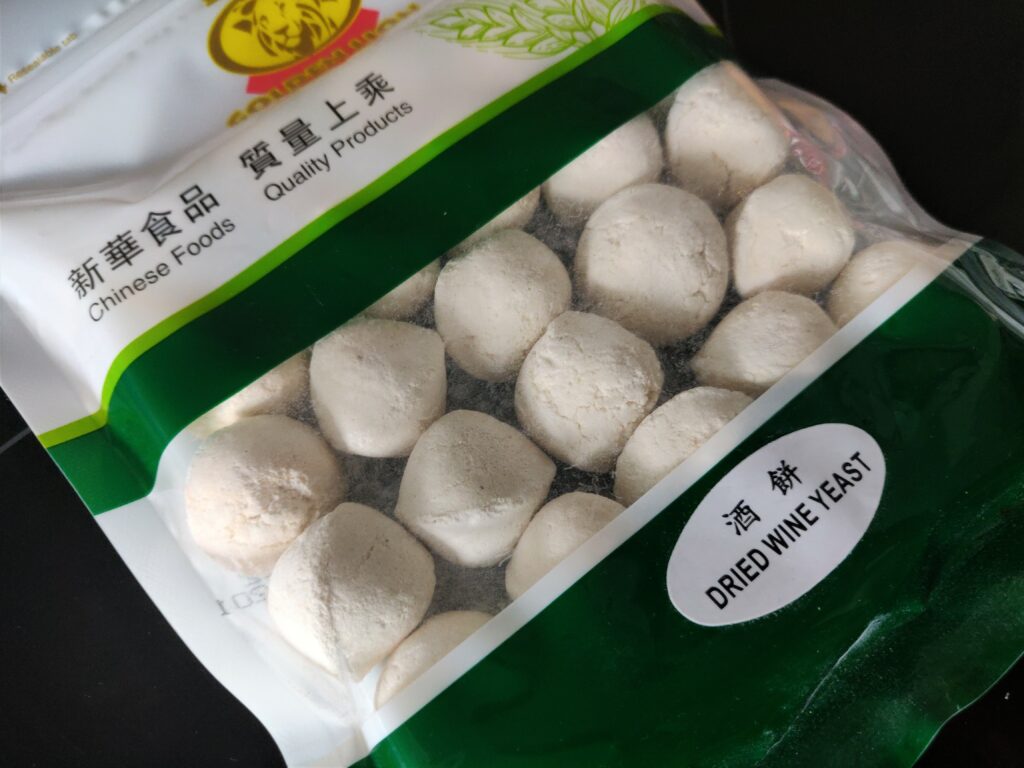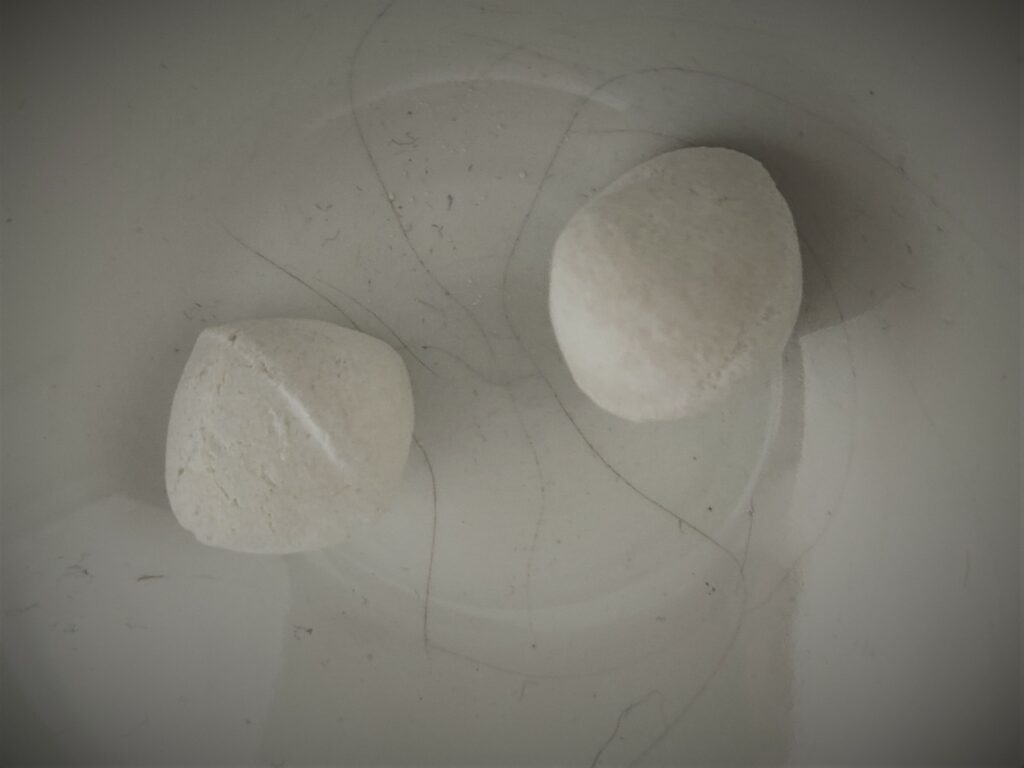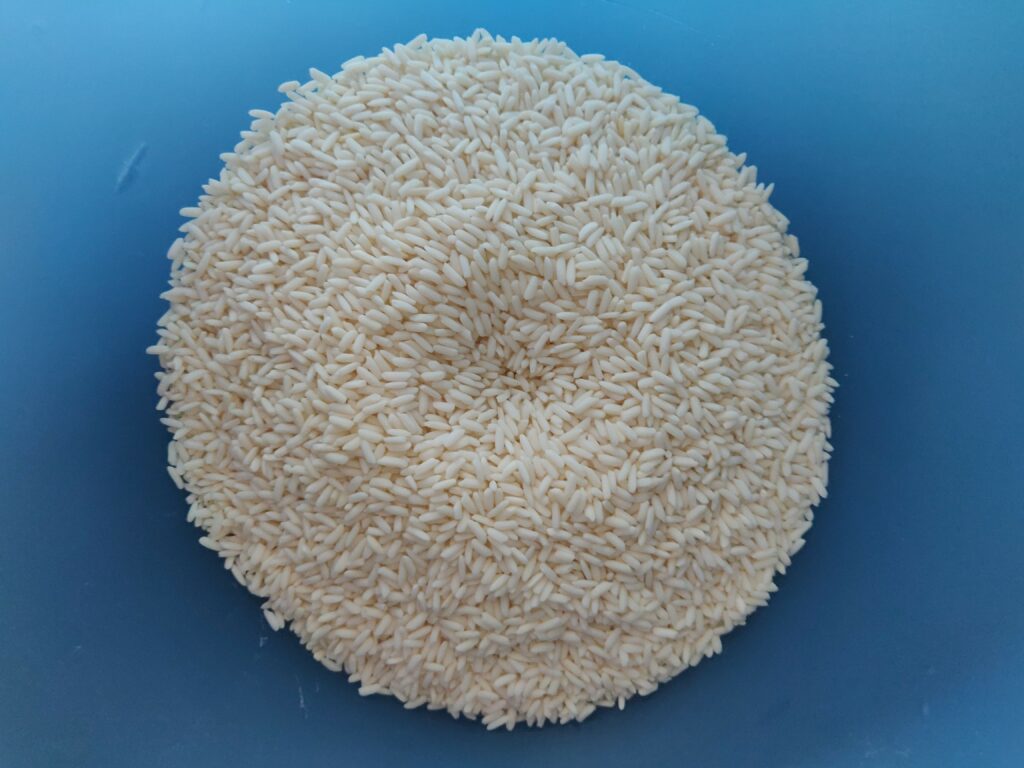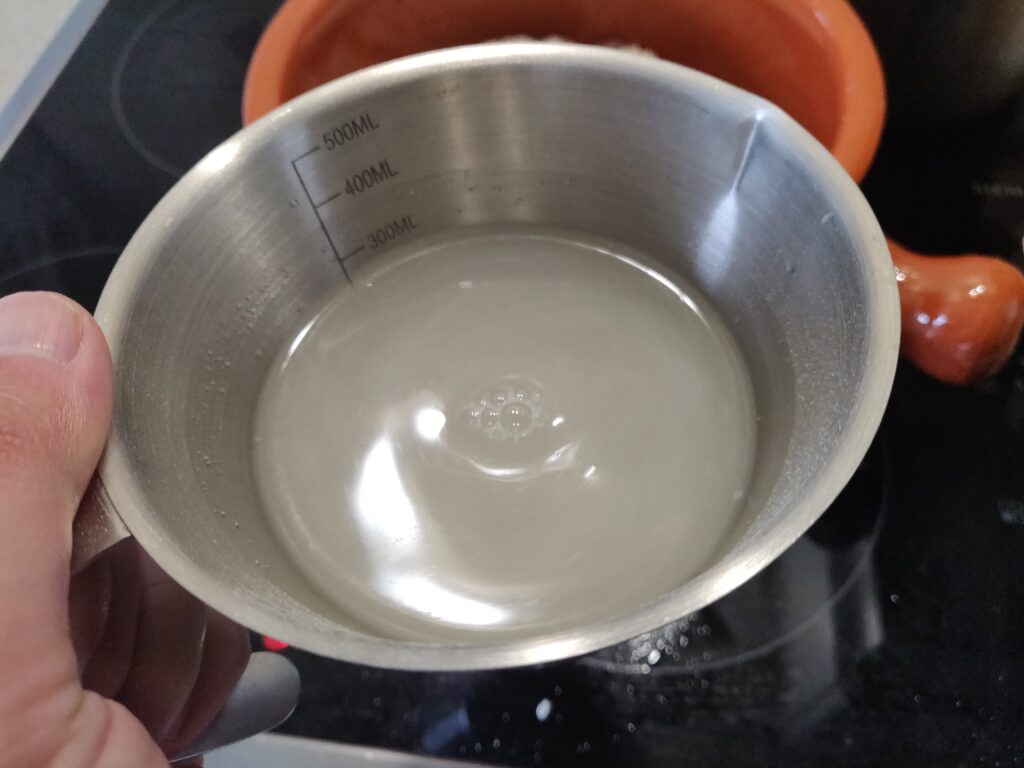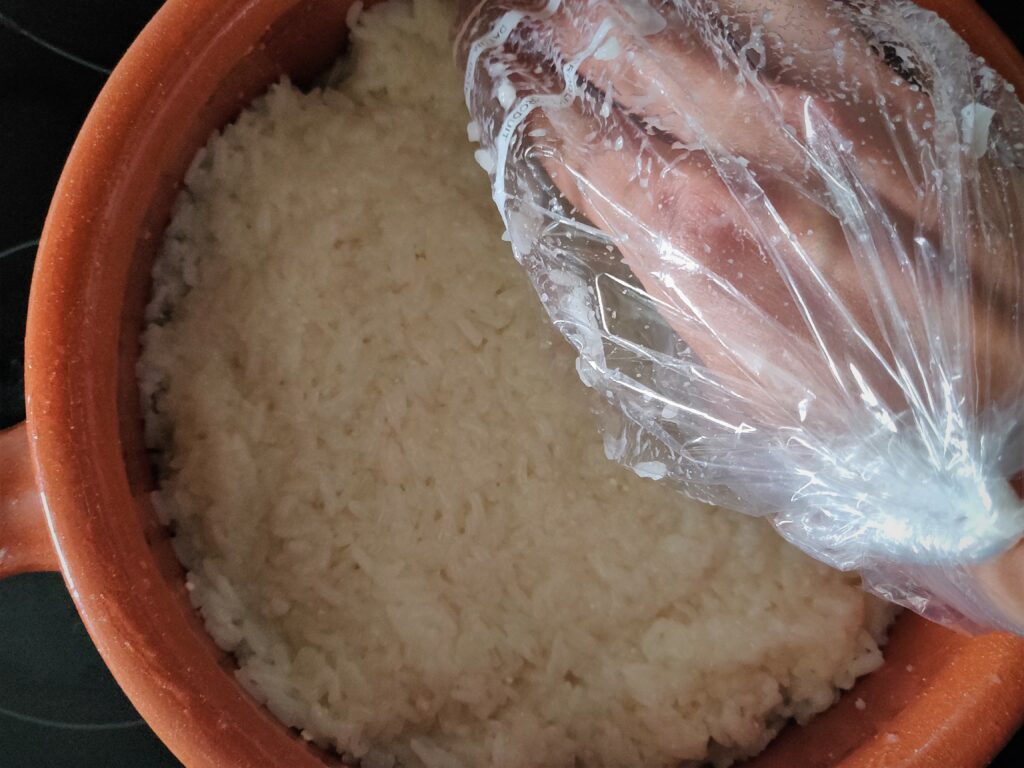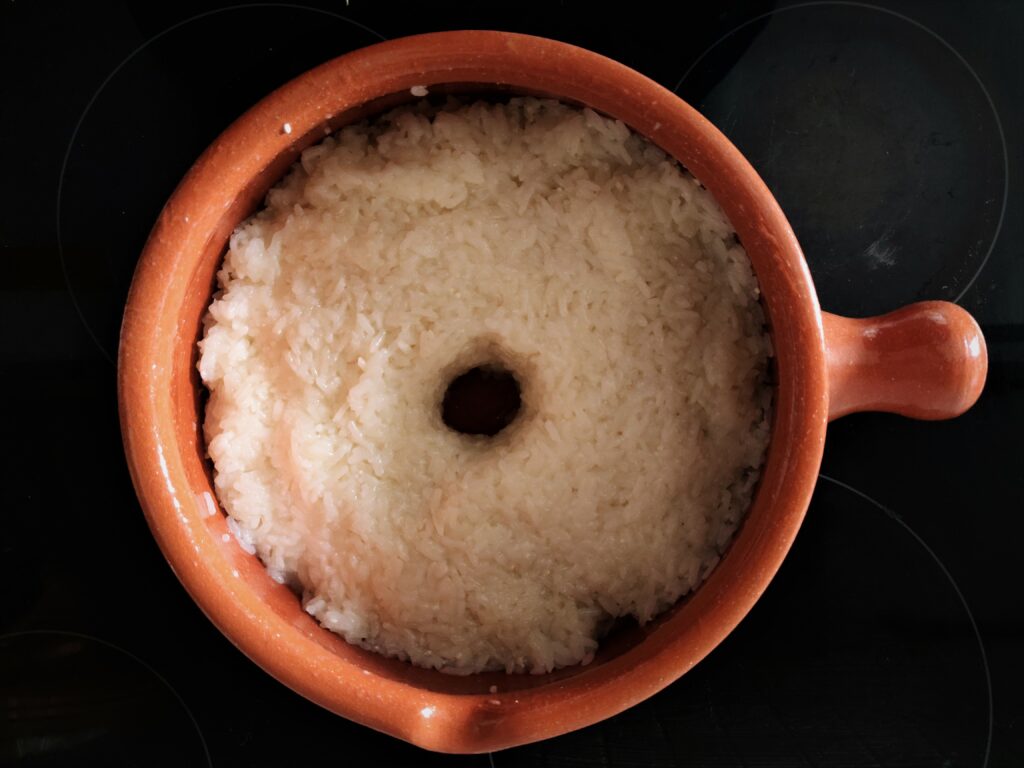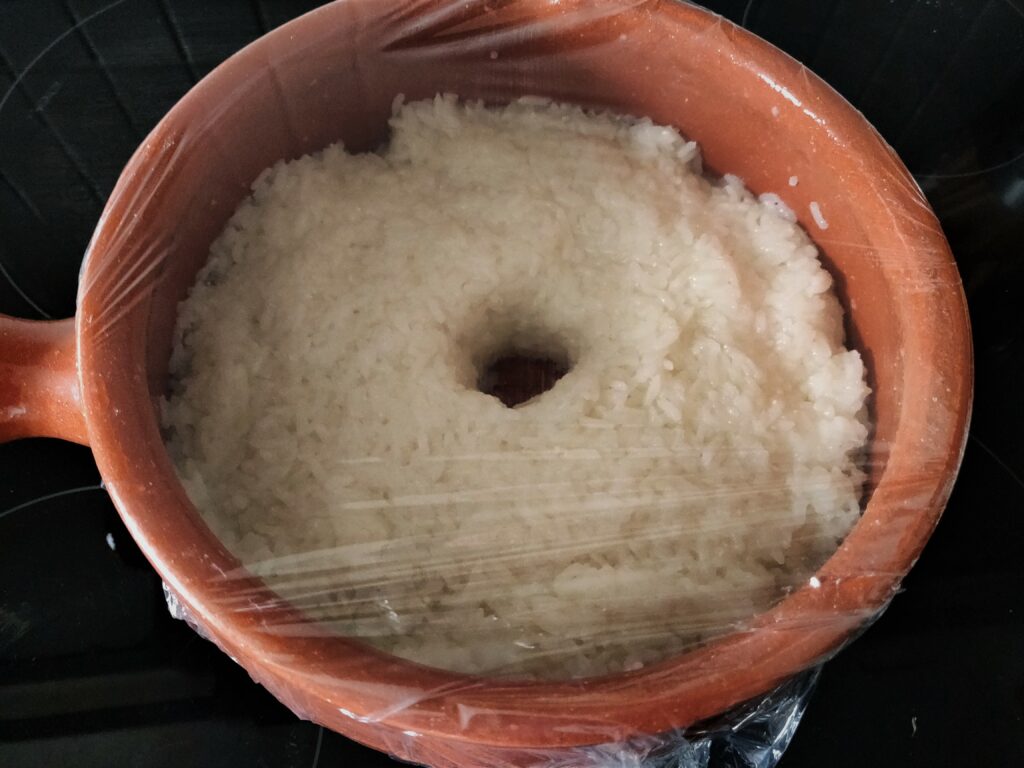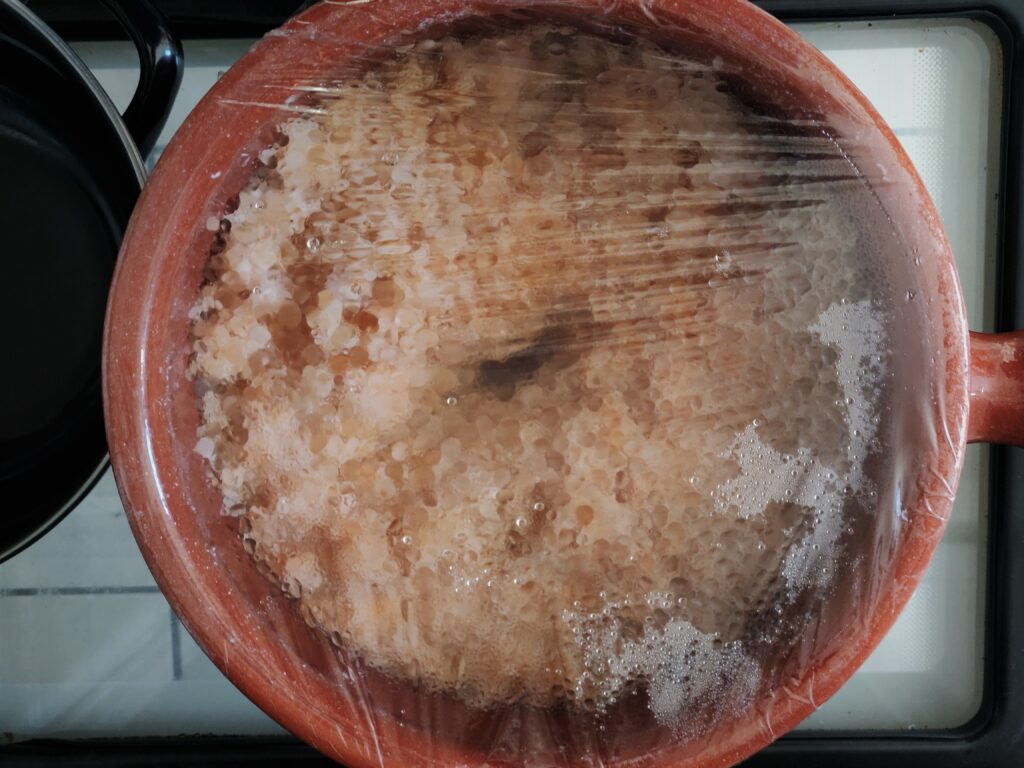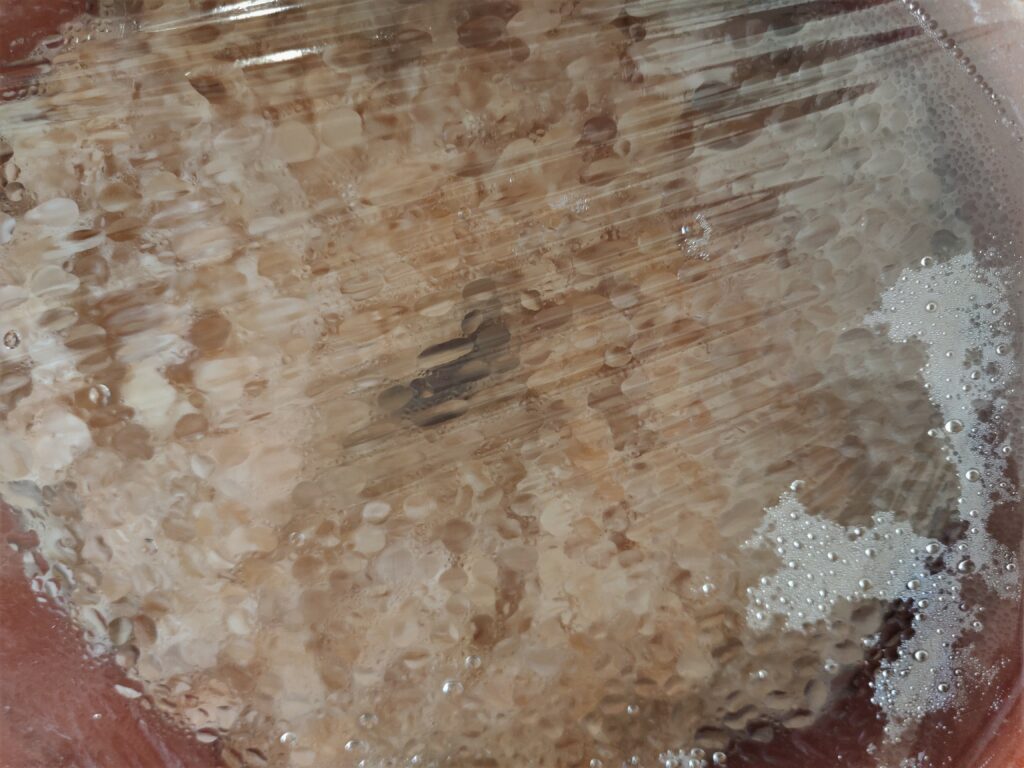‘Jiuniang‘ 酒酿, also known as ‘Laozao‘ 醪糟, is a traditional homemade Chinese sweet rice liquor. Unique to the Han Chinese population, this practice is popular in ethnic Han communities in central, northern and western parts of China, as well as in migrant Han enclaves such as the Hakkas 客家 in southeastern coastal China and on Taiwan island.
Jiuniang 酒酿 is very similar to the Sikhye 식혜 in Korea and the Amazake 甘酒 in Japan.
Jiuniang 酒酿 tastes sweet and has a low alcohol content of 1.5 to 2 percent. It is made by fermenting cooked glutinous rice for about 5 days, hence it is a young rice alcohol. Further fermentation will either result in a full rice wine or rice vinegar, depending on the temperature and yeast content. To make and preserve jiuniang, the fermentation has to be halted by storing the liquor at 10 degrees celsius.

What is the history of Jiuniang 酒酿?
The ancient name of Jiuniang 酒酿 is Li 醴. The earliest records of the term date to the 2nd to 3rd centuries AD:
“又野王岁献甘醪膏饧。”
History of the later Han, Volume 32” 《后汉书·樊传》 (6-189 AD)
On the birthday of Lord Youye, tributes of sweets and Li were made.
It was claimed that during the Western Han Period, citizens were made to build the Mausoleum of Maoling (汉茂陵) for the then Emperor Wu, located in Shaanxi, over 53 years. Jiuniang 酒酿 was said to have been developed here to feed the hungry builders, by combining alcohol and rice. By the Tang Period (618 to 907 AD), this quickly became a staple drink and condiment all over the country.
My ancestor, the renowned poet, Du Pu 杜甫 (712-770 AD) left a poem 《孟仓曹步趾领新酒酱二物满器见遗老夫》 (Meng the Granary Manager gave me two jugs of newly-brewed Jiuniang) about his love for Jiuniang 酒酿:
楚岸通秋屐,胡床面夕畦。
《孟仓曹步趾领新酒酱二物满器见遗老夫》
藉糟分汁滓,瓮酱落提携。
饭粝添香味,朋来有醉泥。
理生那免俗,方法报山妻。
You were trodding through a path by the River Chu that cuts through the autumn's debris, When I looked up from my chair, facing the open fields, one evening. Carrying full jugs that were dripping With the wine, freshly separated from the rice residue. Oh, it adds such fragrance to my coarse meals and drunken joy to visiting friends! I don't think I can ever live without this new habit. Please teach my unskilled wife how to make it.
How do you consume Jiuniang 酒酿?
Jiuniang Wanzi 酒釀圓子 (Jiuniang Rice Balls)
The Chinese has the habit of eating a dessert composed of pasta-like balls made with rice flour called Tang Yuan 湯圓 in a light syrup. When you add Jiuniang 酒酿 to a portion of rice balls, it is called Jiuniang Wanzi 酒釀圓子.
Jiu Cao Ji 酒糟鸡 (Jiuniang Chicken)
This is a very common Han Chinese dish. It is basically stir-fried chicken braised in Jiuniang 酒酿 towards the end of the cooking process.
Nailao’er 奶酪兒 (Jiuniang Yoghurt)
This is a typical Beijing snack. Jiuniang 酒酿 is added to milk at room temperature and left overnight. The process will coagulate the milk to become a yoghurt-like snack. It tastes sweet and alcoholic.
Apart from these dishes, Jiuniang 酒酿 is used in Han Chinese cuisines wherever you use rice wines like Shaoxing wine. It helps to get rid of odours, soften fats in meat and increase the umami of dishes.
What are the health benefits of consuming Jiuniang 酒酿?
Jiuniang 酒酿 contains glucose, antioxidants and Vitamins B1 and B2.
In Chinese medicine, it is not suitable for pregnant women but it is often eaten after delivery to help new mothers produce milk.
Traditionally, Jiuniang 酒酿 is consumed a lot more in autumn and winter to help promote blood circulation. People who feel cold all the time or older people who suffer from fatigue and lethargy should consume warm Jiuniang 酒酿 to increase energy levels.
What is Jiuqu 酒麴?
Often translated into English as ‘wine yeast‘, Jiuqu 酒麴 – or sometimes written as Jiubing 酒饼 – is an alcohol starter.
You absolutely need this in order to make your own Jiuniang 酒酿. Jiuqu 酒麴 contains either Rhizopus oryzae and/or Aspergillus oryzae as well as other yeast types. Different starters influence the fermentation period and process. So you may have to experiment with starters of different brands and origins to find the one you like best.
About this recipe: Using rice cooker
Traditionally, making Jiuniang 酒酿 requires you to soak the glutinous rice overnight. This is because compared to white rice, glutinous rice cook less easily. The traditional way to cook glutinous rice is by steaming. Hence the soaking process is required in order to first soften the rice.
This recipe however uses an electric or microwave rice cooker. This makes sure your rice is cooked thoroughly without having to be soaked. This really makes the process faster and more efficient!
This recipe also recommended placing your fermentation pot in an oven. Once heated, the enclosed environment makes sure that the temperature does not plunge below 20 degrees celsius. Of course, if you are living in the tropics, the fermentation pot can be placed just anywhere in a dark corner of your house.
Ingredients:
- 500g ’round’ glutinous (sticky) rice
- 500ml filtered or mineral water
- 250ml filtered or mineral water
- 1 piece Jiuqu starter 酒饼/酒麴
Utensils:
- Electric rice cooker
- Oven
- Glazed earthern/Ceramic pot, with a cover
- Food-grade plastic freezer bag
- Plastic wrap
- Glass container with airtight cover with a 750ml or 1l capacity
Instructions
- Wash your rice cooker pot with soap. Rinse with boiling water. Then wipe clean.
- Rinse your glutinous rice repeatedly until the water is relatively clear.
- Place your rice in your rice cooker with 500ml water. Mix well, and let it cook.
- Once the rice is cooked, let it to cool down until around 30 degree celsius. Not warmer and not when the rice is completely cold.
- During this time, place your Jiuqu starter inside a fresh, never-used-before, food-grade plastic bag (normally used to store food in a freezer). Crush it finely with a pestle or a rolling pin.
- In a sterilised bowl, add 250ml room temperature water and mix in the crushed Jiuqu starter with a sterilised tablespoon.
- Once the cooked rice is cooled to around 30 degree celsius, use a sterilised spoon to transfer it into the fermentation pot.
- Pour the Jiuqu starter solution evenly onto the rice.
- Turn the freezer bag you have used before to crush the Jiuqu starter inside out and massage the starter solution into the rice using your hand through the bag.
- Once done, make a well hole in the centre of about 5cm in diameter, for you to check the fermentation process later.
- Cover the fermentation pot completely with plastic wrap. Make sure it is completely airtight! Place the pot cover on top to make sure light doesn’t go through.
- Warm your oven to around 30 degrees celsius, switch it off, and place your fermentation pot in there.
- Wait for 5 days.
- If you do not have an oven or an oven that can be used over 5 days, place your fermentation pot in a dark, warm spot (between 22-28 degreee celsius) of your house.
- You can check from time to time through the plastic, whether alcohol has developed inside the well in the centre. This should happen by Day Two. DO NOT remove the plastic even for a second to check the fermentation.
- If you notice the rice turning black or there is mold growing on the rice, that means there has been a leak and the yeast has been overcome by other organisms. The fermentation has thus failed.
- After Day Five, you can already transfer your wine and some of the rice into an airtight sterilised glass container with a 750ml or 1l capacity. Place it immediately in the fridge to stop the fermentation. It would keep the Jiuniang 酒酿 fresh for up to one year.
- Or you can wait until Day Eight or Ten to have a stronger liquor, which is less sweet, quite sour, a lot more bubbly, and has a higher alcohol content.
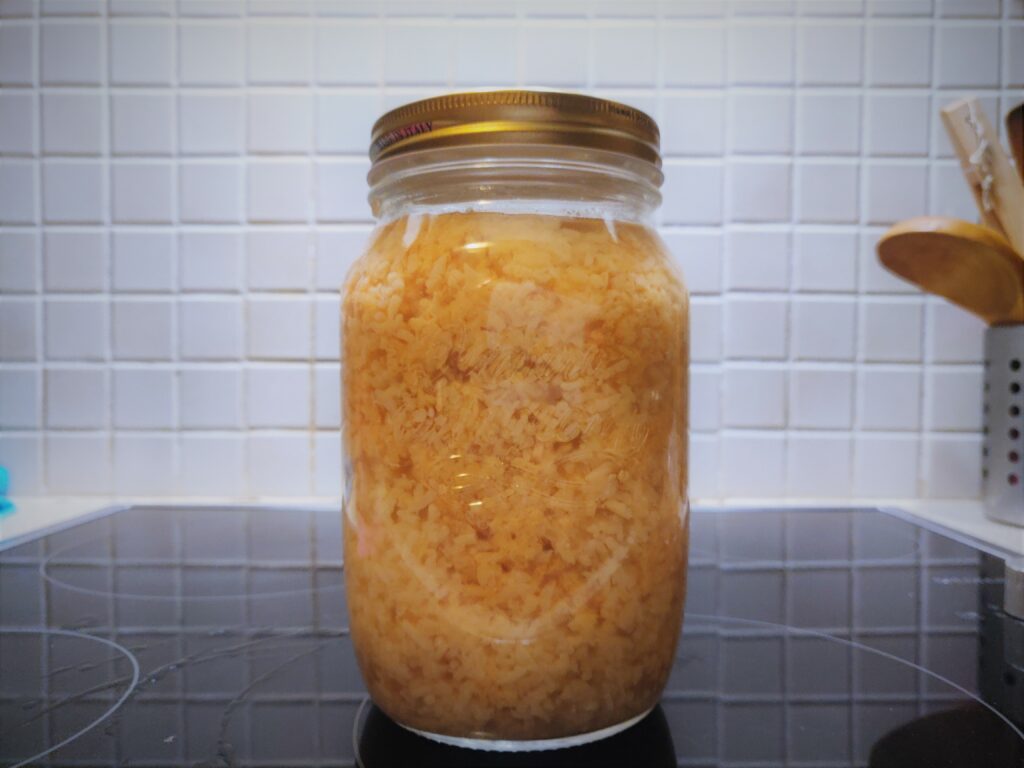
Very important tips to note:
Do not soak your rice overnight.
Traditionally, the glutinous rice is first soaked overnight to facilitate the cooking by steaming for about 30 minutes. Because the fermentation can only happen when the rice is fully cooked. Using the rice cooker method, your glutinous rice will have been fully cooked. Overcooking the rice will result in very soft rice, and create a very thick murky liquor full of rice taste. So you may have Jiuniang 酒酿, but it cannot be used because of the texture.
Mix in your Jiuqu starter at the right temperature.
The yeast needs heat to be activated. Pouring the yeast solution into cold or room temperature rice, will not activate the fermentation. Conversely, rice that is still steaming or too hot will kill the Jiuqu starter, which will not result in any fermentation.
Keep it airtight until the liquor is ready.
I failed midway in my fermentation process because I peeled back the plastic to smell the liquor for 5 seconds. That killed the fermentation process halfway when bacteria got in during that very short period of time and my Jiuniang 酒酿 was spoiled the very next day. Also, do not trust some websites or Youtubers who claim you need to leave a small hole or loosely covered top supposedly because fermentation needs oxygen and it releases a lot of gas. Well, that basically turned my whole pot into a mold farm! Sometimes, Youtubers do things to attract views by claiming their method is the most foolproof or easiest. That is simply irresponsible.
Keep it warm at a constant temperature.
I also failed in the beginning because it is now autumn in Europe where I live, and my kitchen is too cold. I placed my fermentation pot above my fridge thinking it is enough because my room temperature is around 19 or 20 degrees celsius. Nope, it did not even ferment because that is too cold for the yeast to be active even though they were activated in the beginning. That is when I discovered the oven. I also fired up the oven from time to time during fermentation to give the yeast a nice temperature boost. Note that you should remove your pot before heating up the oven and wait for the oven to reach maximum 30 degrees celsius before putting the pot back in. Whatever it is, do not let your fermentation pot go below 20 degrees.
Do not ever touch the rice with your hands.
Your fermentation will spoil because there is oil OR any bacteria other than the Jiuqu starter. Which is why all utensils need to be first washed with soap to get rid of any form of grease and then sterilised with hot boiling water before being used. Do not think of touching the rice or wine with your fingers or hands even for a short while, as this will contaminate your rice with bacteria harmful to the yeast.
Use round glutinous rice.
Both long and round glutinous rice can be used, but round glutinous rice is said to produce a sweeter Jiuniang 酒酿.
